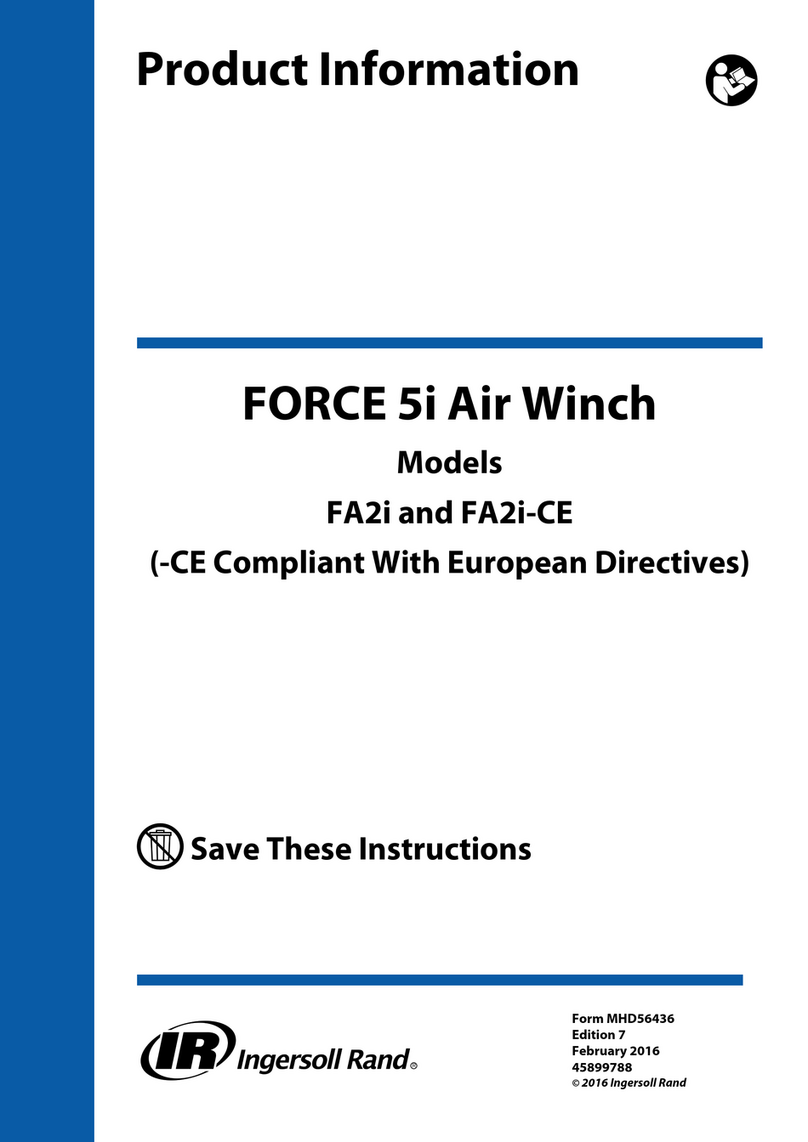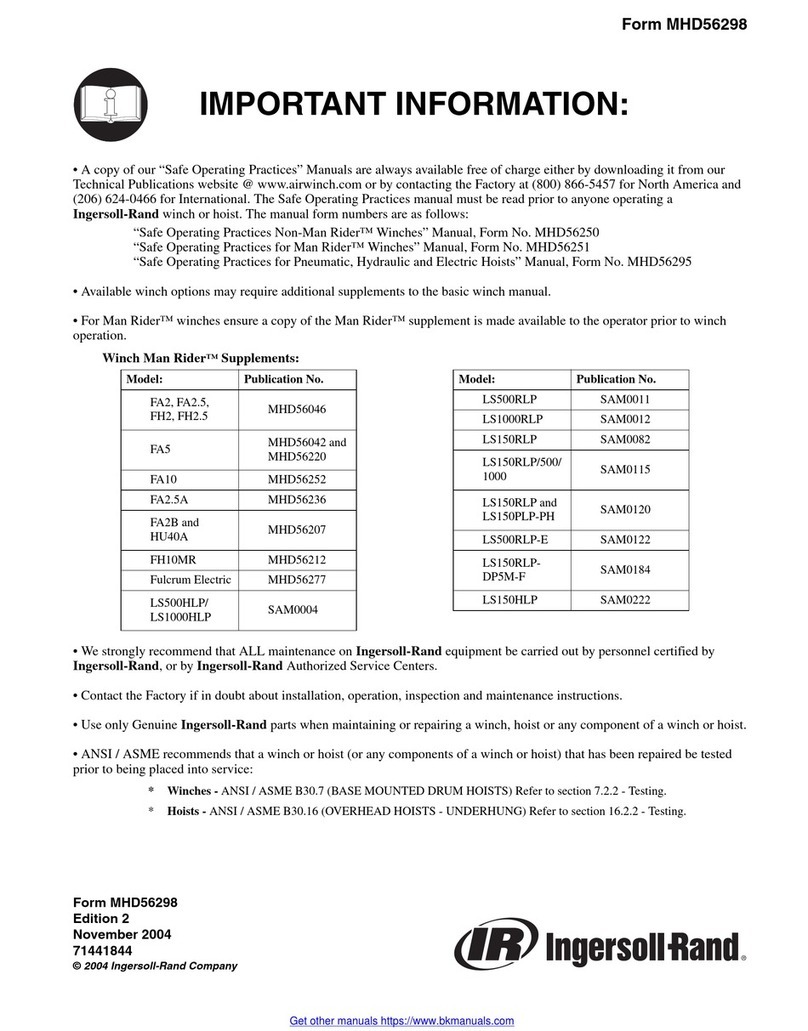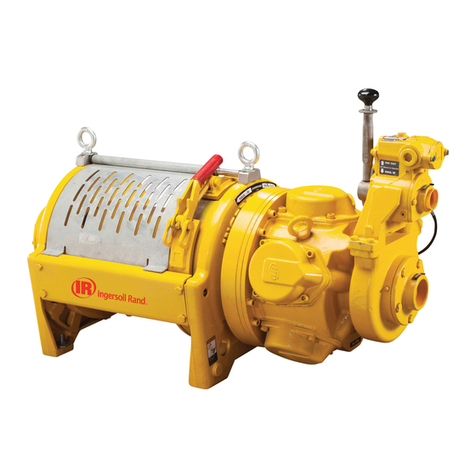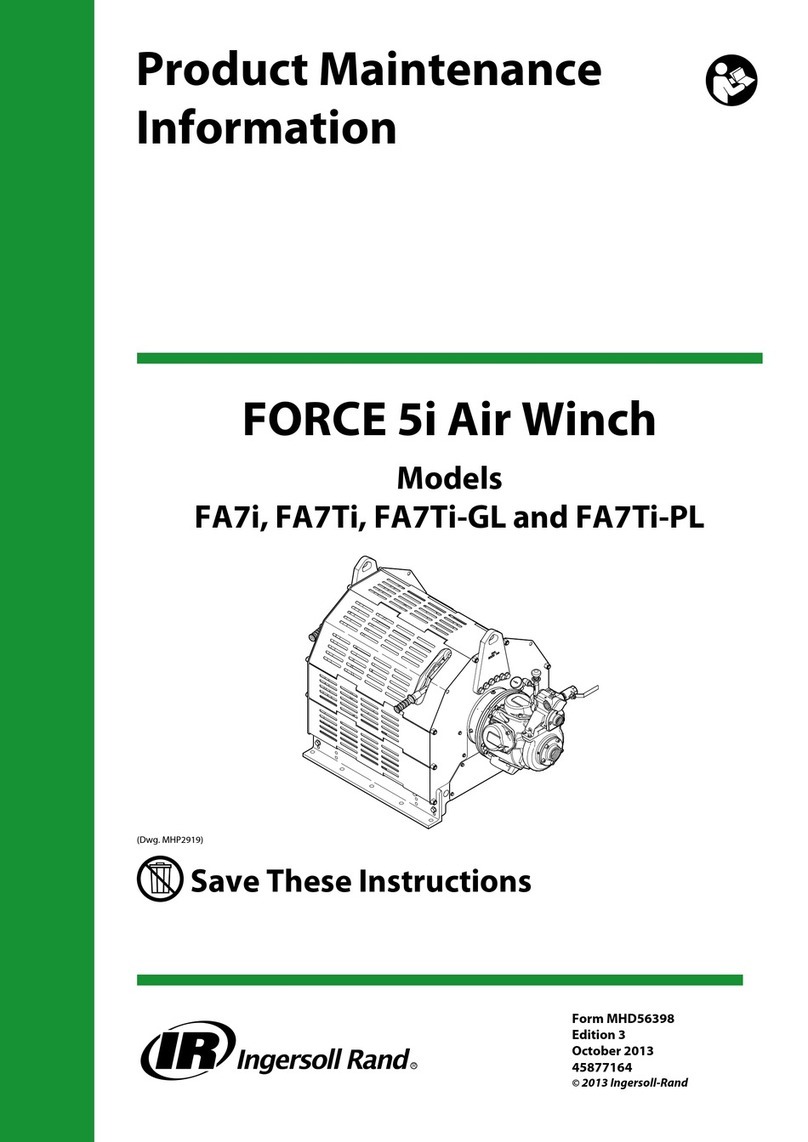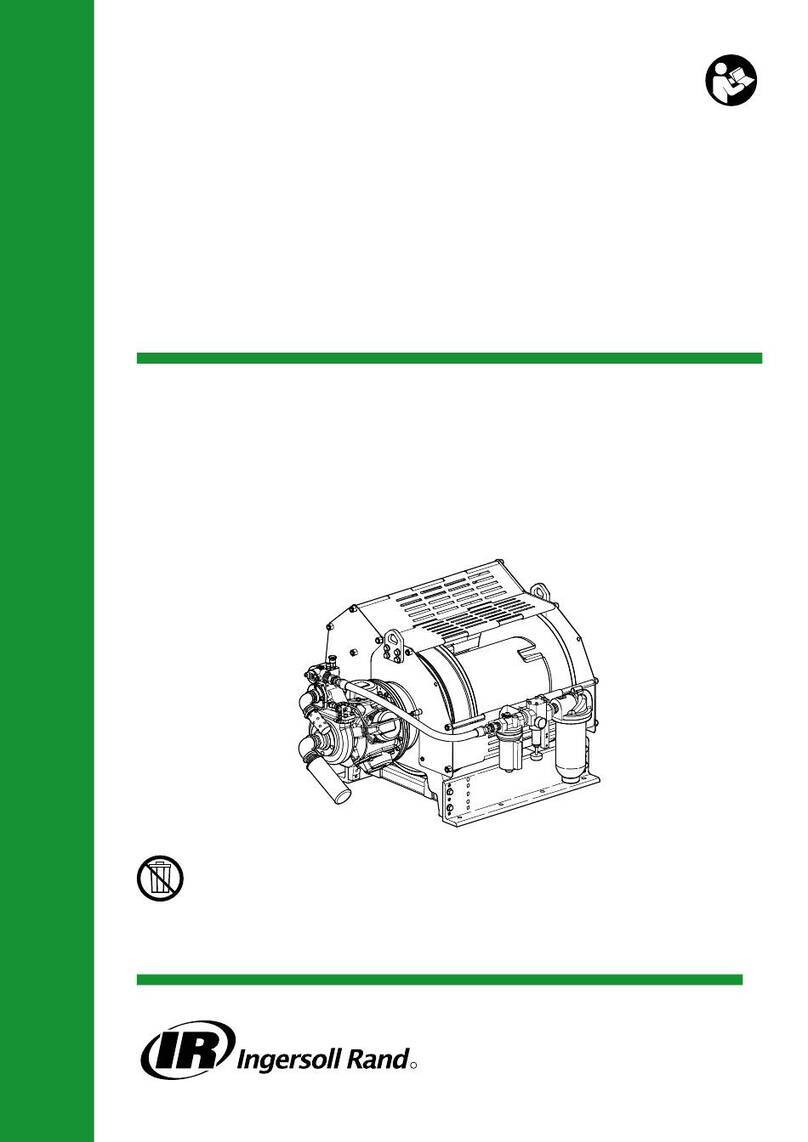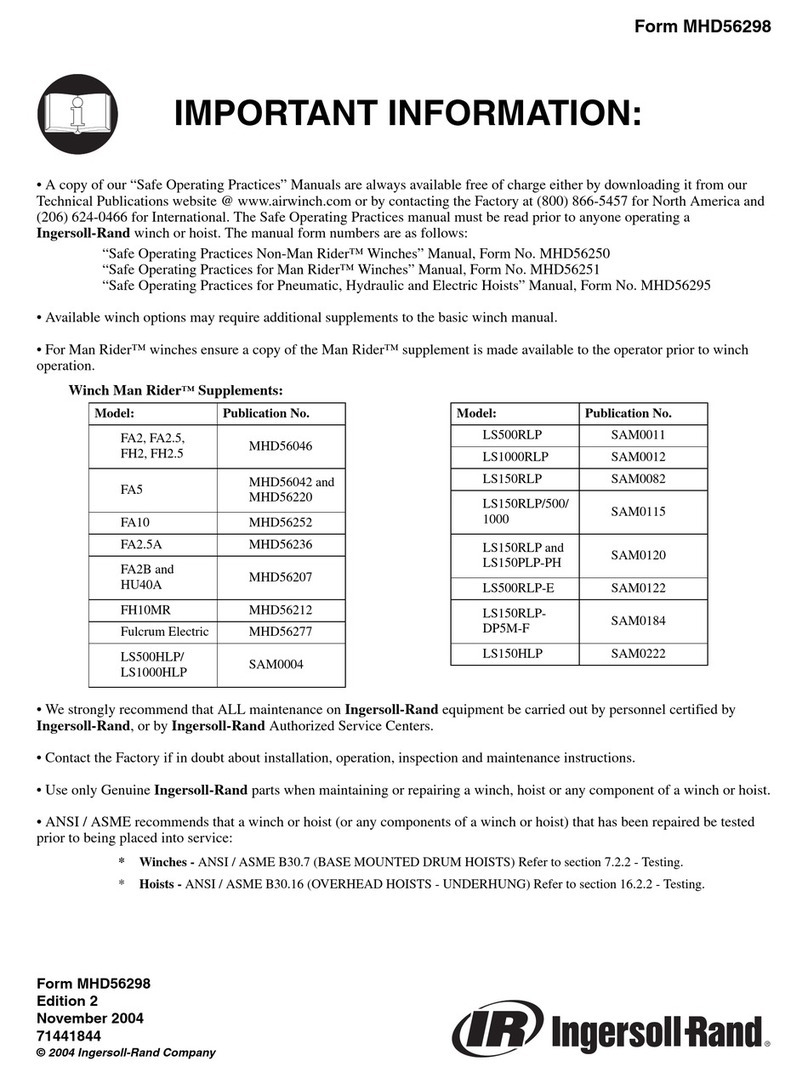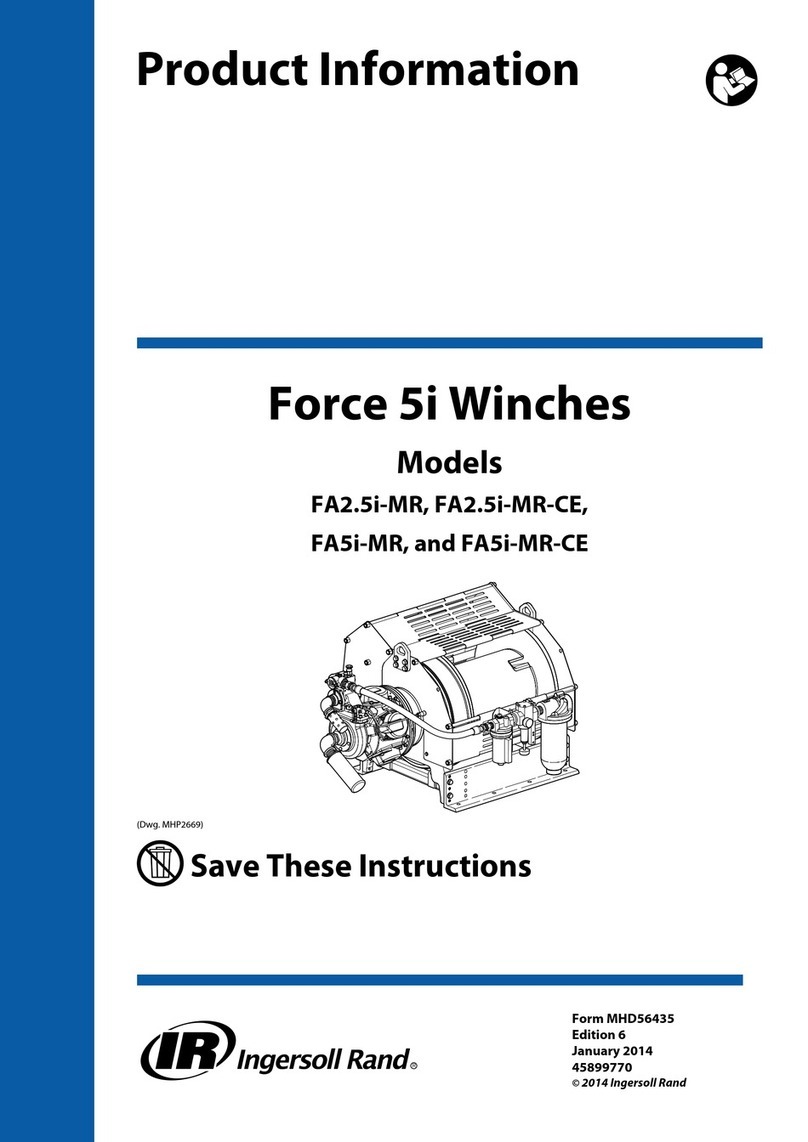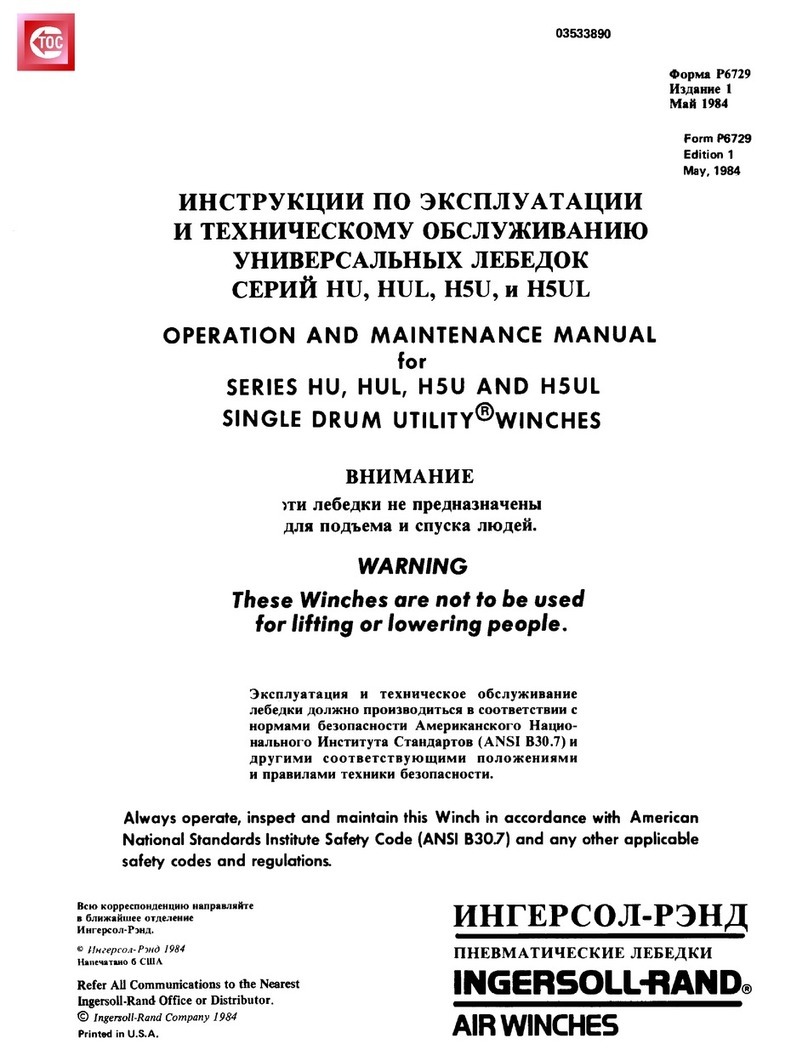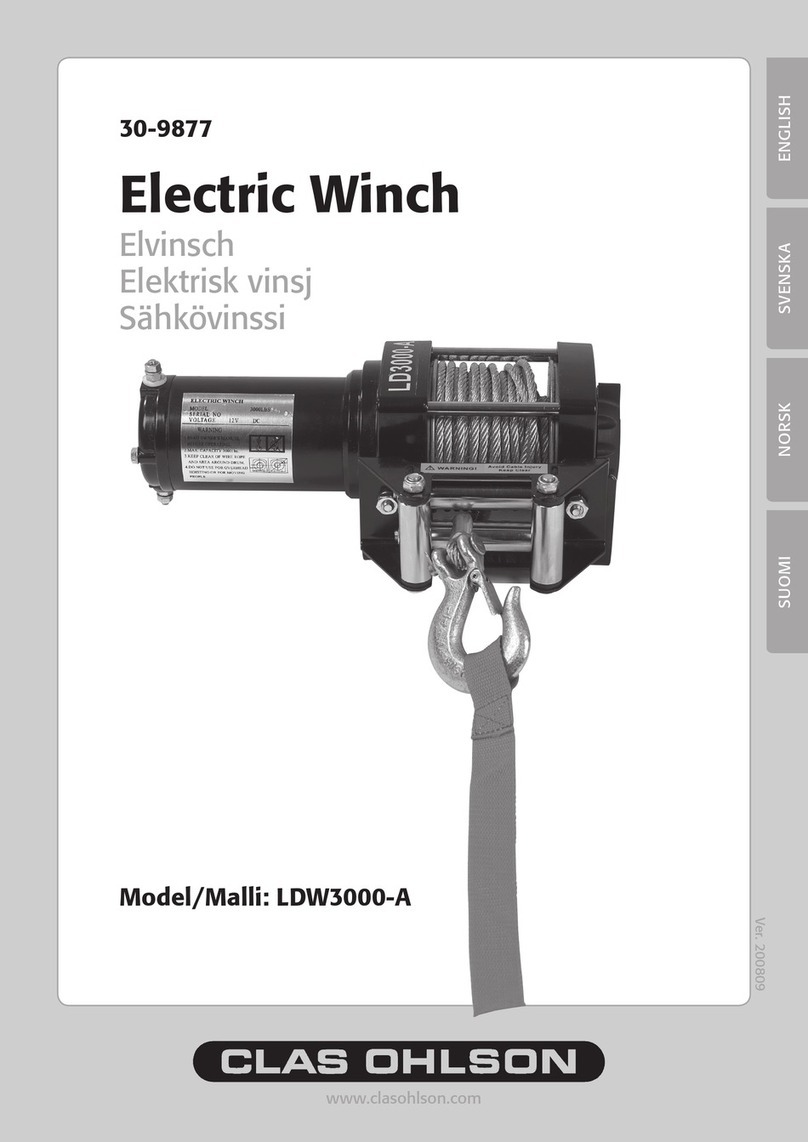
INSPECTION
Inspectioninformation isbased inpartonAmericanSocietyofMechanicalEngineers
Safety Codes (ASME B30.17).
WARNING
• All new or repaired equipment should be inspected and tested by
Ingersoll Rand trained Technicians to ensure safe operation at rated
specifications before placing equipment in service.
•Never use a winch that inspection indicates is damaged.
Frequent and periodic inspections should be performed on equipment in regular
service. Frequent inspections are visual examinations performed by operators or
Ingersoll Rand trained Inspectors and include observations made during routine
equipment operation. Periodic inspections are thorough inspections conducted by
Ingersoll Rand trained Technicians. ASME B30.7 states inspection intervals depend
upon the nature of the critical components of the equipment and the severity of
usage. Refer to ‘Inspection Classifications’ chart and ‘Maintenance Intervals’ chart in
ProductMaintenanceInformationManualforrecommendedmaintenanceintervals.
Careful inspection on a regular basis will reveal potentially dangerous conditions
while still in the early stages, allowing corrective action to be taken before the
condition becomes dangerous.
Deficiencies revealed through inspection, or noted during operation, must be
reported to designated personnel to ensure corrective action is taken.
A determination as to whether a condition constitutes a safety hazard(s) must be
decided, and the correction of noted safety hazard(s) accomplished and
documented by written report before placing the equipment in service.
nWire Rope Reports
Records should be maintained as part of a long-term wire rope inspection program.
Records should include the condition of wire rope removed from service. Accurate
records will establish a relationship between visual observations noted during
frequentinspectionsandtheactual conditionofwireropeasdeterminedbyperiodic
inspections.
nFrequent Inspection
On equipment in regular service, frequent inspections should be made by operators
at the beginning of each shift. In addition, visual and audible inspections should be
conducted during regular operation for indications of damage or evidence of
malfunction (such as abnormal noises).
Disassembly may be required as a result of frequent inspection findings or in order
to properly inspect the individual components. Disassembly steps are described in
the Product Maintenance Information Manual.
1. Surrounding Area: Visually check for winch oil leaks. Do not operate winch if
leaking oil is found. Ensure surrounding area has no slippery surfaces and is
obstruction free.
2. HosesandFittings:Visuallyinspectfordamage, airleaksandlooseconnections.
Repair all leaks or damage and tighten lose connections prior to starting daily
tasks.
3. Manual Shut-off Valve: Test shut-off valve to ensure proper operation and free
movement.
4. Guards: Verify wire rope does not contact guard during winch operation and
that guards are secure and undamaged.
5. Winch: Visually inspect winch housings, control(s), external brake, siderails and
drum for damage. Check that all external bolts are in place and secure. Report
damage to supervisor and request additional inspection by a Ingersoll Rand
trained Technician.
6. Winch Operation: Power winch in both directions. Winch must operate
smoothly without sticking, binding or abnormal noises and have minimal
vibration.
7. HydraulicSystem:Check hydraulic lines, fittings, valves and other components
for deterioration, leakage or wear. Tighten, repair or replace as necessary. Check
reservoir sight gauge for proper hydraulic oil level. Check dirt alarms at both
pressure and return line filters for visual indication of dirty filter.
8. Pendant (optional feature): Ensure operation of pendant levers is smooth and
winch is responsive to pendant control. Pendant levers must spring return to
the neutral position when released.
9. Manual Throttle Lever: Ensure operation of manual throttle lever is smooth
and winch is responsive to lever movement. Lever must return to neutral and
lock in place when released. If winch responds slowly or controls stick, do not
operate winch until all problems have been corrected.
10. Wire Rope: Visually inspect all wire rope which can be expected to be in use
duringtheday’soperations.Inspectforwearanddamageindicatedbydistortion
of wire rope such as kinking, “birdcaging,” core protrusion, main strand
displacement, corrosion, broken or cut strands. If damage is evident, do not
operatewinch untilthe discrepancieshave beenreviewed andinspected further
by personnel knowledgeable on wire rope safety and maintenance procedures.
NOTICE
•Thefullextentofwireropewearcannotbedeterminedbyvisualinspection.
At any indication of wear inspect wire rope in accordance with instructions
in “Periodic Inspection.” Refer to Product Maintenance Information
Manual.
11. Wire Rope Spooling: Visually check reeving and ensure wire rope feeds on and
off the drum smoothly. Verify spooling direction (overwind or underwind) is
correct for winch and application.
12. Brake(s): Lift and lower the load a short distance to test brake(s). Brake(s) must
hold load without slipping. Automatic brake must release when winch control
throttle is operated. If brake(s) do not hold load or do not release properly, they
must be adjusted or repaired.
13. Lubrication: Refer to “LUBRICATION” sectionon page 5 for recommended
procedures and lubricants.
nWinches Not in Regular Use
1. Equipment which has been idle for a period of one month or more, but less than
six months, shall be given an inspection conforming to the requirements of
“Frequent Inspection” before being placed in service.
2. Equipment which has been idle for a period of over six months shall be given a
completeinspectionconformingwith the requirements of“PeriodicInspection”
before being placed in service. Refer to Product Maintenance Information
Manual.
3. Standby equipment shall be inspected at least semiannually in accordance with
the requirements of “Frequent Inspection”.
nStoring The Winch
1. Always store the winch in a no load condition.
2. Wipe off all dirt and water.
3. Oil the wire rope.
4. Place in a dry location.
5. Beforereturningwinch toservice, followinstructionsfor ‘WinchesNotIn Regular
Use’ in the “INSPECTION” section on page 5.
LUBRICATION
To ensure continued satisfactory operation of winch, all points requiring lubrication
must be serviced with correct lubricant at proper time interval as indicated for each
assembly.
Refer to ‘Maintenance Interval’ chart in Product Maintenance Information Manual
for recommended lubrication intervals. Use only those lubricants recommended.
Other lubricants may affect winch performance. Approval for use of other lubricants
must be obtained from your Ingersoll Rand distributor. Failure to observe this
precaution may result in damage to winch and/or its associated components.
Table 6: Lubrication Intervals
Intervals Lubrication Checks
Monthly
Lubricate components supplied by
grease fittings.
Inspect and clean or replace oil filter.
1 Year or 1,000 hrs of Winch Operation Check reduction gear oil level.
Change Gearbox Oil
nComponent Lubrication
Correct lubrication is one of the most important factors in maintaining efficient
winch operation.
1. The recommended grade of oil must be used at all times. Use of unsuitable oil
may result in excessive temperature rise, loss of efficiency and possible damage
to lubricated components. Refer to ‘Recommended Lubricants’
sectionon page 6.
2. It is recommend that the first oil change be done after approximately 50 hours
initial operation. Always inspect removed oil for evidence of internal damage
(metal shavings, dirt, water, etc.). Thereafter, drain and replace oil according to
Table 6 ‘Lubrication Intervals’ on page 5.
3. Always inspect removed oil for evidence of internal damage or contamination
(metal shavings, dirt, water, etc.). If indications of damage are noted, investigate
and correct before returning winch to service.
4. After winch operation, allow oil to settle before topping off.
5. Always collect lubricants in suitable containers and dispose of in an
environmentally safe manner.
WARNING
• Use recommended grade of oil to prevent extensive heat build up and
prevent wear that could cause sparks. Oil levels must be properly
maintained.
Form MHD56359 Edition 2 5




